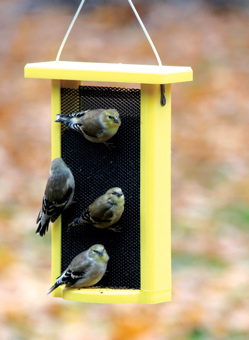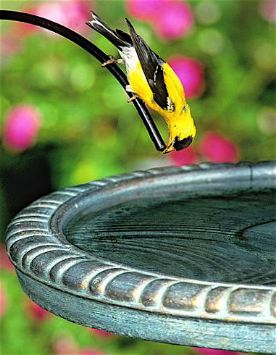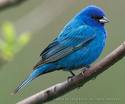-
A New Kind of Finch Bird Feeder
Some of the new backyard birding products are great, and some…well, not so great.
This Finch Bird Feeder by BirdsChoice is definitely one of the great ones! A new design for feeding thistle (or nyjer seed) has arrived. A patented material called magnet mesh attracts more birds to cling to the feeder. Unlike other finch feeders in the traditional tube style, this one allows for “all-over” perching for more birds to feed at once.
With it’s recycled bright yellow frame, the rectangular shape allows for even seed distribution. The difference being no seed clumping at the bottom to become moldy and wasted. Constructed of durable poly lumber, and polyester powder coated black screen, this unique finch bird feeder comes with a lifetime guarantee. The smaller version shown here holds 1.5-quarts of thistle seed, while the large feeder has a 3-quart capacity.
When Goldfinches’ colors fade in late fall, it’s best to leave feeders out year-round for them. They’re still around, sans the vibrant plumage. Leaving your finch feeders out year round pretty much guarantees that fantastic vibrant summer plumage. Since Goldfinches are also one of the last birds to breed, hanging nesting material in your yard will entice them to stick around.
-
Finch Bird Feeders Have No Seasonal Preference
Unlike hummingbird or fruit feeders for migratory and some songbirds, finch bird feeders are a welcome addition to any garden or yard virtually year-round. You’ll be graced with the most gorgeous lemon yellow plumage in warmer months, only because Goldfinches are one of the few birds experiencing two molts per year. They’ve even earned the nickname “wild canary”.
These colorful birds flock to finch bird feeders and chow down on thistle! In fact, they eat it almost exclusively and nestlings are fed the same. This food has added benefits; squirrels ignore it, and it is non-germinating which means that spilled food won’t turn into weeds.
Some of the longer tube feeders can cause problems with clumping, damp food at the bottom. If your feeder is not busy enough to have finches eat all of the thistle, (also called nyjer seed) on a regular basis, it can clump when it gets damp, molds and turns rancid. Then the attraction for our feathered friends will quickly fade. A feeder that distributes seed more evenly is one solution to this problem. The Finches Favorite 3-Tube feeder is a perfect example of this practice. Plus you can see all 24 birds eating at once, which is a truly spectacular site!
You can also try working with your existing feeder to alleviate this problem, Something I have tried is buying a few inexpensive ping pong balls and putting them inside my finch feeder. The thistle is fine, so it flows around the ping pong balls and is available to the birds. But the balls take up space in the feeder, reducing the amount of food it holds. The result: less food in the feeder means less clumping and fresher food. You can add or remove balls until you get the right balance of food and space for your feeder and your habitat.
Happy Birding!
-
Finch Feeders Feed More Than Just Finches
Now say that five times real fast!
Goldfinches aren’t the only birds who will feast on thistle seed or finch mixes. You’re likely to see House and Purple Finches, Eastern Towhees, Juncos, Pine Siskins and Indigo Buntings at finch feeders if they’re native to the area.
With warmer months upon us, the payoff for keeping our finch feeders out year round shows. The brightest lemon yellow birds ever, grace the yards of those who offer thistle or nyjer seed to these sweet-natured birds.
They’re also the one of the latest birds to breed, so if you haven’t gotten any nesting material up yet, there’s still plenty of time. When other birds are finished their breeding season, Goldfinches start – late June to early July.
As always, offering a daily fresh water source will greatly increase the number of birds, as well as species seen in your yard. Birdbaths are an excellent attractor for any birds!




